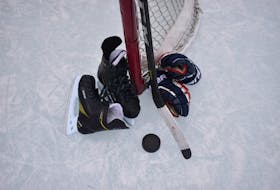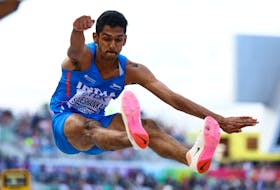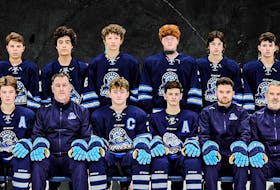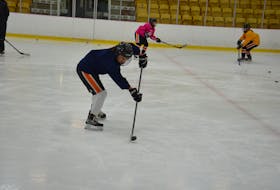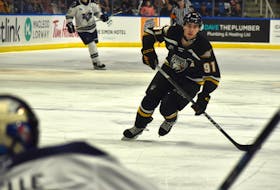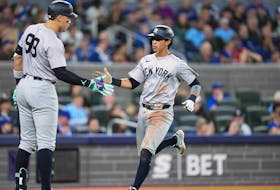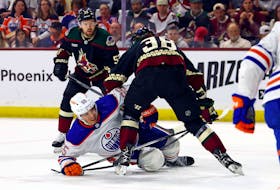ST. JOHN'S, N.L. — I was recently asked what stands out in my memory about the Toronto Maple Leafs’ first training camp in St. John’s, what turned out to be a visit abbreviated by world events.
My answer to that was of a player with his back turned to his teammates amid the sound of bagpipes.

It was Sept. 16, 2001, five days after terrorists hijacked passenger planes in the U.S., crashing two of them into the World Trade Centre in New York, another into the Pentagon in Washington and another into an empty Pennsylvania field.
The tragedies led to cancellation of airline traffic all over North America, including a couple of Leafs charters that were to have flown that same Sept. 11 to St. John’s, where the team was to have begun its camp at a brand-new Mile One Centre.
After days of uncertainty, during which time a quickly-converted Mile One served as a hostel/staging area for thousands of stranded airline passengers, the Leafs did arrive in town. The practice part of training camp wouldn’t go ahead, but the team played a blue-and-white intra-squad game, followed a day later by a scheduled NHL exhibition matchup against the Montreal Canadiens.
My memory comes out at the start of that blue-white game.
The player was second-year pro Jeff Farkas, the only American-born player on the Maple Leafs roster at the time. A native of Amherst, N.Y., just outside Buffalo, Farkas lost friends who had been working in the World Trade Centre on Sept. 11, and he knew Los Angeles Kings scout Mark Bavis, who died in one of the commandeered planes that crashed into the Twin Towers, leading to their collapse.
Before the game, as the St. John’s Bagpipe Band played a hymn, the Leafs players stood at centre ice, the split squads facing each other.
All except for Farkas, who had turned to face the American flag, hanging at the far end of Mile One, and remained that way, head bowed, even for some time after the last sounds of the bagpipes had drifted away.
He later spoke about the previous days, which had been a struggle for him, how maintaining a focus on hockey had been difficult. However, Farkas, who had been the AHL St. John’s Maple Leafs’ rookie of the year the previous season, also talked about how important he felt it was for the Leafs to be at Mile One, both as a thank you to Newfoundlanders who had been welcoming stranded, bewildered and frightened citizens of the world, and as a way of providing, even if it was for a couple of hours, some diverting entertainment.
But getting here hadn’t been easy.
First there were the logistical problems. Even after airspace had reopened, there was the question about whether the jammed-up St. John’s International Airport could handle the charters as it concentrated on getting stranded planes back in the air, or even whether there would be sufficient aviation fuel to refill the planes bringing in the Leafs, and later the Canadiens.
And there was always the thought, as Maple Leafs’ president Ken Dryden said, about whether “they had the right to play,” if the hockey teams would get in the way of the important work being done in Mile One, in particular, and St. John’s, in general.
If, for example, they would take up hotel space needed for those still marooned.
But Glenn Stanford, president of the AHL Leafs and then general manager of Mile One, lobbied for the parent team to come if possible, even if it was for a short while, saying the Leafs’ presence was something Newfoundland could use, maybe even needed, at the time.
With Maple Leafs’ owner Steve Stavro, always an advocate of the Leafs having their farm team in St. John’s, as a catalyst, that’s what happened.
Farkas had talked about how it wasn’t easy getting on a plane just days after 9-11. And there were many players leaving behind young families, children still confused and anxious in the wake of what happened.
But like Farkas, there was a sense of obligation, reinforced by what they witnessed going on around them once they arrived in St. John’s.
That included their experience in pre-game skates prior to the exhibition games, practice sessions conducted in front of the world, if you will. Mile One was still being used as a staging area for passengers awaiting outbound flights, and as departures were announced on the Mile One loudspeaker and sections of seats would empty as a result, the players would pause the workout to say farewell in that most hockey of fashions, by tapping their sticks on the ice.
And those in the stands had applauded, too, when the Leafs hit the ice for the first time. Most had become aware of the hockey subplot to the story in which they were featured, and all, even those who weren’t hockey fans, some who had never seen a hockey game before, wanted to show their appreciation.
The passengers had sort of practiced that welcome a couple of days before, in one of those incidents that, thankfully, led to smiles amid all the dismay and apprehension of that week.
AHL Leafs head coach Lou Crawford was already in St. John’s with his family, which included school-age children. With nothing much to do hockey-wise, he and assistant coach Russ Adam decided to leave their Mile One offices and go for a skate.
So, dressed in Leafs-logoed garb, they stepped onto the ice to a loud standing ovation from stranded passengers who assumed they were the first of the arriving Toronto contingent.
And technically, they were clapping for NHLers. Lou Crawford had played 26 games for the Boston Bruins, while Adam had suited up for eight games with the Leafs in 1982-83.
In fact, it turned out there was a third NHLer skating, although nobody knew it at the time. That’s because future Buffalo Sabre Luke Adam, then 11, had joined his dad and Crawford on the ice.
Some of those applauding passengers were still at Mile One for Sunday’s intra-squad contest and Monday’s Leafs-Habs exhibition, watching the games from a jerry-rigged seating area in a still-to-be completed restaurant.
In doing so, they got to see a cheque for $1 million presented to “Give to Feel Good,” a program to benefit health care in the province, the result of donations from the Leafs, Canadiens, Molson Brewery and other sources, all doubly matched by the provincial government.
And they got to hear Dryden sum up, in a few words, why the Leafs were glad to be there.
“You've proven to have done your best as a community," he said. "Tonight, we will do our best."
It was acknowledgement of a city and province whose citizens had acted — in the words that titled the hymn the bagpipe band had played — with “Amazing Grace.”
[email protected]
Twitter: @telybrendan

